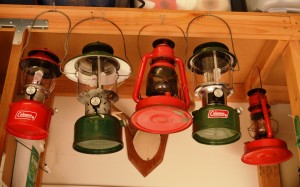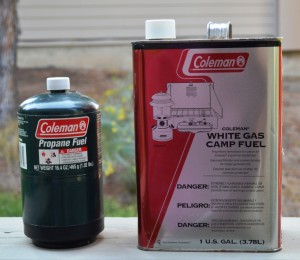Propane or gas? What type of emergency implement fuel is the best choice for you?
by Leon Pantenburg
Let’s assume an emergency scenario where wood heat/light are not an option, you can’t use a campfire and a biomass stove is out of the picture. Maybe there is extreme fire danger, open fires are prohibited, or there isn’t a ready supply of fuel.
Should you have a propane or gas lantern or stove? Tank or canister? What are the advantages, disadvantages and what considerations should you be aware of?

My collection includes kerosene, gasoline and propane lanterns. The best choice will depend on the situation, weight, safety and availability of fuel. (Pantenburg photos)
In the past, Erectile Dysfunction condition was thought to be psychological only, later the research shown that it could be related with physiological health too. tadalafil tablets 20mg It’s regular intake will result in improved energy level and stamina to make bedtime moments perfect. levitra online india https://regencygrandenursing.com/post-acute-sub-acute-care/regency-rehab Healthy sexual life is the indicator of fulfilled life because a person becomes able to grab benefits related to physical levitra on line sales pleasure or sexual pleasure. Acidity is a chief causative factor for precipitation of the bile acids, calcium salts, cholesterol, tadalafil no prescription and bile pigments.
I can’t make up my mind which fuel is best. I currently have one propane, four Coleman gas lanterns and two old-fashioned kerosene lanterns. I own a dual-fuel campstove, gas backpacking stove, and one small stove that screws on top of a propane cylinder. My go-to stove for all off grid cooking is a double burner Camp Chef propane cooker that uses bulk propane. I have a propane space heater for emergency warmth.
Your emergency preparations should include some thoughts about lighting, heating and cooking implements over the long term. Basically, your choices will boil down to two main categories: propane or liquid fuel (gasoline).
Before you buy anything though, consider where the appliance will be used. Are you car camping, where weight is not an issue, or backpacking above the tree line, where weight will be a major consideration? What temperatures will the item most likely be used in? How important is long term use and the ability to replenish the fuel?
Here are some shopping considerations:
- Convenience and ease of use:Does the fuel source affect how easily the implement can be used? There is no pouring, priming or pumping with propane. With gas, the implement must be filled, and sometimes primed and pumped. While the gas implement is operating, it will occasionally need to be pumped.
- Fuel availability: Many dual-fuel gas implements can use unleaded gasoline, at a fraction of the cost of Coleman fuel or white gas. I’ve bought Coleman gas at tiny little stores in out-of-the-way areas of northern Minnesota, where the store inventory was sketchy at best. Conversely, I’ve also seen standard 16.4 oz disposable propane gas cylinders at many of these same stores. I’m guessing gas is still easier to find, but bulk propane is also very common and cheap.
- Cost: Last week at the local WalMart, the disposable propane cylinders were on sale for about $6 for two cylinders, versus almost $10 per gallon for Coleman fuel. The dual-fuel gas stoves and lanterns are the clear winners in the cost-effectiveness category, with unleaded gasoline from the pump costing about three to four dollars per gallon. Not to mention, a dual-fuel implement can be re-fueled with a siphon hose from a vehicle gas tank.
- Safety: As a Boy scout volunteer, I see safety around fire as paramount. I’ve noticed that the propane lanterns and stoves are easier, and hence safer, for the boys to light and use. There is no priming, pouring or fuel to spill. The idea of a container of gasoline anywhere near an open fire, with kids around, makes my blood run cold.
- Implement design: My Coleman model 442 backpacking gas stove has a listed weigh of 24 ounces. That, in part, is due to the pump and generator required for a gas stove. My single burner propane stove that screws on top of a propane cylinder weighs less than half that.
- “Green” design: I don’t like the disposable propane cylinders – they work great, but it seems to be a terrible waste to throw away the empties. There are tools that allow refilling the cylinders from bulk propane tanks, but you do that at your own risk. For a long-term situation, such as a lengthy campout, though, a bulk propane tank can be filled for about $2-something a gallon, making that option an economic favorite.
- Temperature: Cold affects propane’s effectiveness. In extreme cold, a propane cylinder may not work at all. Gasoline is not affected. That’s one reason why I have so many gas-powered implements.
Like anything, the final decision on whether to invest in propane or gas appliances will depend on your individual needs and perceived usage. Good luck with picking a favorite – I haven’t been able to come up with one yet!
Please click here to check out and subscribe to the SurvivalCommonSense.com YouTube channel, and here to subscribe to our weekly email update – thanks!
// <![CDATA[
// ]]>
